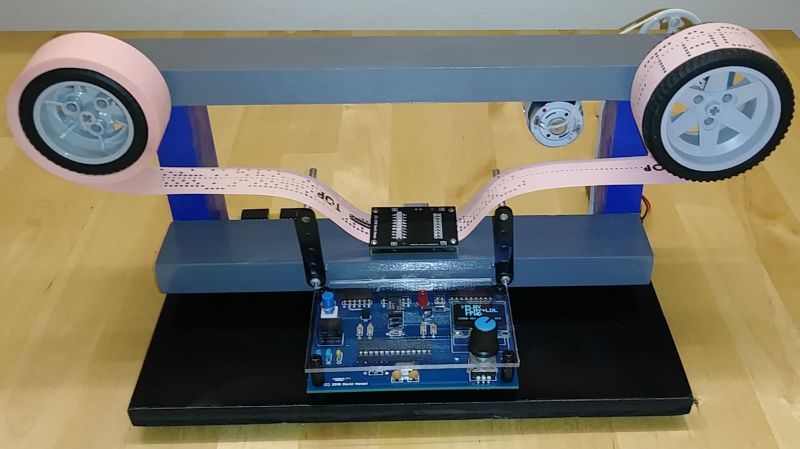We may be a bit biased, but the storage media of yesteryear has so much more personality than that of today. Yes, it’s a blessing to have terabyte SD cards smaller than your pinky nail and be able to access its data with mind-boggling speed. But there’s a certain charm to a mass storage device that can potentially slice off your finger.
We’re overstating the dangers of the venerable paper tape reader, of course, a mass storage device that [David Hansel] recreated a few years back but we only just became aware of. That seems a bit strange since we’ve featured his Arduino-based Altair 8800 simulator, which is what this tape reader is connected to. Mechanically, the reader is pretty simple — just a wooden frame to hold the LEGO Technic wheels used as tape reels, and some rollers to guide the tape through a read head. That bit is custom-made and uses a pair of PCBs, one for LEDs and one for phototransistors. There are nine of each — eight data bits plus the index hole — and the boards are sandwiched together to guide the paper tape.
The main board has an ATmega328 which reads the parallel input from the read head and controls the tape motor. That part is important thanks to Altair Basic’s requirement for a 100- to 200-ms delay at the end of each typed line. The tape reader, which is just being used as sort of a keyboard wedge, can “type” a lot faster than that, so the motor speed is varied using PWM control as line length changes.
Thanks to [Stephen Walters] for the tip.
















That doesn’t look too shabby. Our ICL1916 (I think, though it may have been 1915) reader back in the 1970s did 1000cps without motorised reels; the input tapes went into a compartment on the right that had a perspex door and the feed was a motorised pinch roller just to the left of the optical head on the left side. The output tape simply spewed out into a big metal bin on the left and had to be wound manually using a little hand powered winder, and that was the point at which you could slice your hand – not off, but you could get a really nasty paper cut if you didn’t get it right.
ICT 1916 Brochure:
https://archive.org/details/bitsavers_icticl1900apeReaderSep64_1249231/mode/1up?view=theater
That’s the one, thank you for that. The catch bin was evidently not worthy of a picure, though it was the size of the lower cabinet and was a standard accessory according to the brochure (not surprising unless you wanted hundreds of feet of paper tape on the floor). I see from the brochure that it could handle up to 700 feet with a power feed but that must have needed a different arrangement to ours because: it was just the box in the picuture with nothing but the curved aluminium strip at the bottom. I can’t imagine winding up 700 feet of tape by hand, our payroll runs used several rolls around 250 feet long and that was bad enough – you needed one feeding them in and one rolling them up to get any sensible throughput. Some of the highways jobs could take over an hour to get the data in, there was that much tape; how times have changed!
Just so.
The Honeywell DDP-516 was similar. Paper tape at 1000cps flying 2m horizontally into a large bin was quite an impressive sight :)
2017 You have mentioned the David Hansel project on the former Arduino project, but with the new project hub site it is gone.
https://create.arduino.cc/projecthub/david-hansel/arduino-altair-8800-simulator-3594a6
Get it on the Wayback internet archive
https://web.archive.org/web/20221205143858/https://create.arduino.cc/projecthub/david-hansel/arduino-altair-8800-simulator-3594a6
Is there a modern DIY paper tape punch project in existence? If I was to go this route I would avoid the punch altogether, generating the output on a paper tape thermal printer and then reading it optically.
All nice, but from where you get the paper tape and how do you punch it?
If you have access to a home CNC vinyl/stencil cutter (eg. Sillhouette, Cricut etc.) you might like to take a look at my PTAP2DXF tool which generates the DXF to produce n-level (Baudot=5, ASCII=8) paper tapes.
It’s slow and a bit fiddly but it does work!
https://github.com/1944GPW/ptap2dxf
Those are not-so-good memories for me. I remember tripping in the computer lab during finals and the cards went everywhere.
In the late 50’s there was equipment to record and transfer information for Linotype machines for newspapers via punched tape. The idea was that large amounts of data could be transferred that way from printing shop to printing shop, instead of typing it into a repeating telex linked machine and tying up those essential telex lines, reading it over a telephone, or sending pre-made plates. It did require physically transferring the reels from office to office, but it was considered a savings in time and skilled man-hours since the punch tape would in theory at least have the justification and paragraphs already formatted.
…now imagine the amount of paper tape it would take, and the speed you’d have to run it, for a feature-length movie, LOL.
Unagi Electric made one and he has a puncher. He’s a YouTube channel in case you didn’t know.